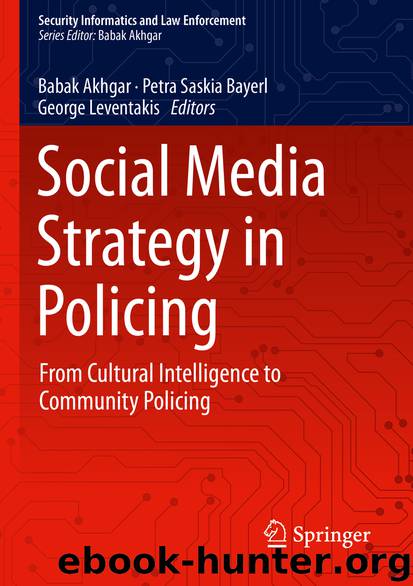Social Media Strategy in Policing by Babak Akhgar & Petra Saskia Bayerl & George Leventakis

Author:Babak Akhgar & Petra Saskia Bayerl & George Leventakis
Language: eng
Format: epub
ISBN: 9783030220020
Publisher: Springer International Publishing
Online Offences Attracting Online Opprobrium
The Case of Amanda Todd
The case of Amanda Todd is a very tragic one. It is also a conceptually difficult case as it mixes cyberbullying and digital vigilantism. It all started when the 12-year-old girl Amanda Todd was talked into lifting her T-Shirt by a stranger via webcam (Schütten 2012). A year later, she received messages from a man who threatened to expose the picture “if she didn’t give him a show” (CBC News 2012). After she refused, her picture was sent to her family and friends. She became a victim of cyberbullying as well as bullying in school and became depressive. A couple of weeks before she finally committed suicide at the age of 15, she uploaded a YouTube video in which she described her despair (Schütten 2012).
Cyberbullying means the harassment and intimidation by users (typically youngster) of other users through digital media (Trottier 2017). According to Trottier, DV and cyberbullying are conceptually similar, as both are forms of online persecution. Yet “DV can come as a response to cyber-bullying” (Trottier 2017, p. 62). Hence, what indeed followed after the death of Amanda Todd was classical DV. Anonymous8 targeted a man who they thought was her harasser. But Anonymous exposed the wrong person (Davison 2012). The real offender was a Dutch man who was sentenced to nearly 11 years imprisonment in 2017 for harassing altogether 34 girls and five men online (Rütten and Sendker 2017).
In this case, cyber and real-life mobbing occurred against a girl who lifted her T-Shirt online in front of a webcam. This was followed by online punishment : a classic DV campaign against an alleged offender. Anonymous tried to punish the offender online by naming and shaming, but as it has been the wrong person this case shows the very problematic aspect of DV. If Anonymous had given the information to the police instead of publishing it, the police could have started an investigation with all the rules that a due legal process demands. Instead, Anonymous jumped to conclusions and convicted a man to public humiliation . It seems like this group sees the Internet as a frontier zone. At that time the police were not able to find the offender. Thus, Anonymous tried to substitute law enforcement in trying to provide more security and safety by revealing the suspected offender’s name so that he could not do any more harm.
Links to the countermovement theory are present as well, if we see the leaking in the context of online sexual harassment and paedophiles acting online. Many people consider these phenomena or people as a growing and threatening movement: Paedophile “hunting groups” that act online exist in various countries9 and can be interpreted as a countermovement as well. In this context, Anonymous can be seen as a countermovement against this criminal deviance.
Download
This site does not store any files on its server. We only index and link to content provided by other sites. Please contact the content providers to delete copyright contents if any and email us, we'll remove relevant links or contents immediately.
Whiskies Galore by Ian Buxton(41879)
Introduction to Aircraft Design (Cambridge Aerospace Series) by John P. Fielding(33064)
Small Unmanned Fixed-wing Aircraft Design by Andrew J. Keane Andras Sobester James P. Scanlan & András Sóbester & James P. Scanlan(32743)
Craft Beer for the Homebrewer by Michael Agnew(18140)
Turbulence by E. J. Noyes(7936)
The Complete Stick Figure Physics Tutorials by Allen Sarah(7307)
Kaplan MCAT General Chemistry Review by Kaplan(6866)
The Thirst by Nesbo Jo(6826)
Bad Blood by John Carreyrou(6552)
Modelling of Convective Heat and Mass Transfer in Rotating Flows by Igor V. Shevchuk(6391)
Learning SQL by Alan Beaulieu(6209)
Weapons of Math Destruction by Cathy O'Neil(6142)
Man-made Catastrophes and Risk Information Concealment by Dmitry Chernov & Didier Sornette(5921)
Digital Minimalism by Cal Newport;(5664)
Life 3.0: Being Human in the Age of Artificial Intelligence by Tegmark Max(5474)
iGen by Jean M. Twenge(5366)
Secrets of Antigravity Propulsion: Tesla, UFOs, and Classified Aerospace Technology by Ph.D. Paul A. Laviolette(5309)
Design of Trajectory Optimization Approach for Space Maneuver Vehicle Skip Entry Problems by Runqi Chai & Al Savvaris & Antonios Tsourdos & Senchun Chai(5011)
Pale Blue Dot by Carl Sagan(4912)
